The Ultimate Print Marketing Guide For Any Open House
Enhance your open houses with effective print marketing strategies.

Andrea Schlottman
Published Jan 22, 2019
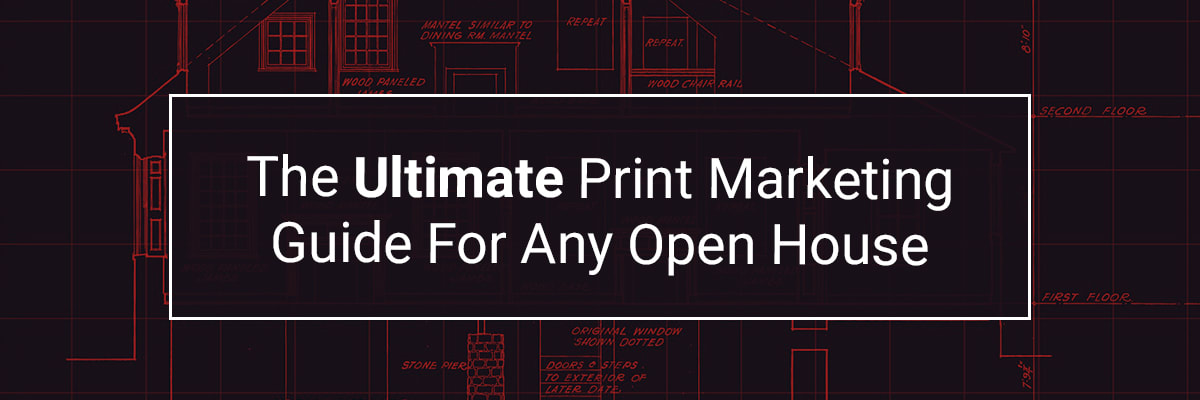 For many real estate agents, the industry s move to digital marketing from Zillow to Instagram to Nextdoor has become a constant game of catch-up. There s always something new to learn, another "latest-and-greatest platform" to try. But you shouldn t let your desire to keep up with the digital Joneses prevent you from utilizing one of the most tried-and-true approaches to real estate marketing: print. That s right! Print is still one of the best tools in any real estate agent s arsenal especially when it comes to open houses. [caption id="attachment_3686" align="alignnone" width="700"]
For many real estate agents, the industry s move to digital marketing from Zillow to Instagram to Nextdoor has become a constant game of catch-up. There s always something new to learn, another "latest-and-greatest platform" to try. But you shouldn t let your desire to keep up with the digital Joneses prevent you from utilizing one of the most tried-and-true approaches to real estate marketing: print. That s right! Print is still one of the best tools in any real estate agent s arsenal especially when it comes to open houses. [caption id="attachment_3686" align="alignnone" width="700"]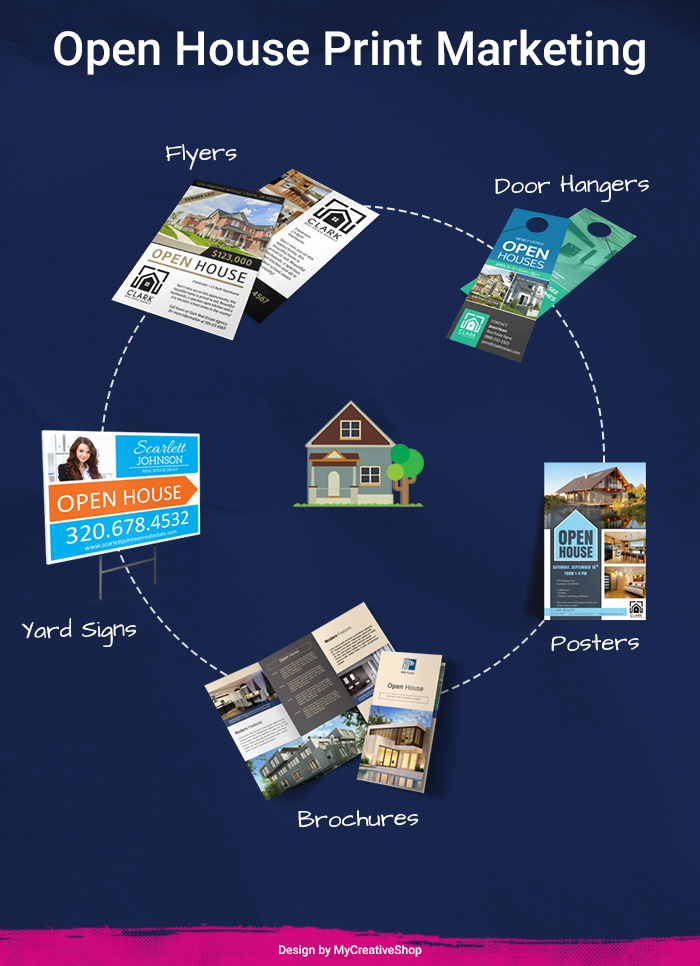 Open House Print Marketing[/caption] The guide below will cover various tips, tricks, and strategies for utilizing print marketing in any open house. We ll start with some general tips for effective real estate print marketing, and then we ll discuss how you can use print to:
Open House Print Marketing[/caption] The guide below will cover various tips, tricks, and strategies for utilizing print marketing in any open house. We ll start with some general tips for effective real estate print marketing, and then we ll discuss how you can use print to: - Bring in potential home buyers before the open house
- Educate and engage visitors during the open house
- Maintain a relationship after the open house
Six Golden Rules of Real Estate Print Marketing
1. Power up your words.
What if we told you that you that you could drastically improve your real estate marketing with just a few keystrokes? It may sound too good to be true, but this isn t some get-rich-quick scheme! It s based on comprehensive research by CoreLogic (who analyzed over 1 million home sales) and economist Paul Anglin (who surveyed more than 20,000 real estate ads). [caption id="attachment_3692" align="alignnone" width="700"]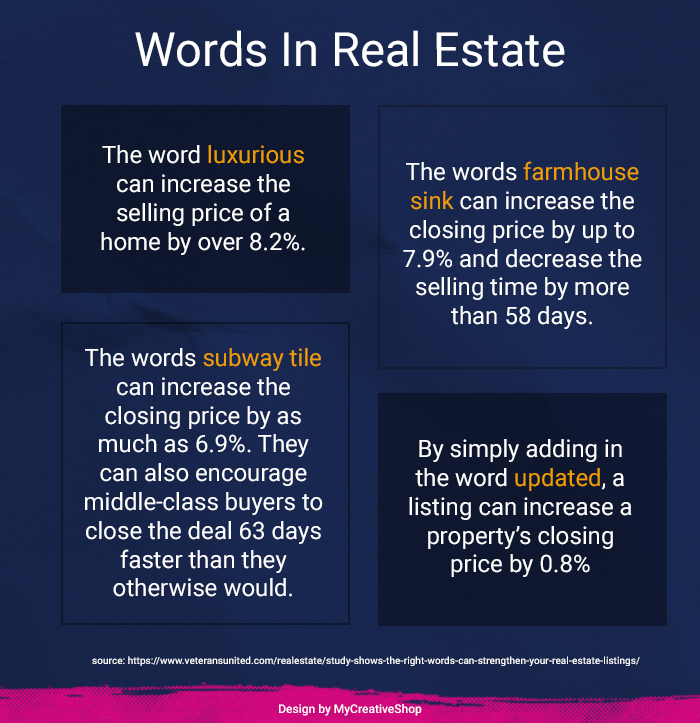 Real Estate Words[/caption] According to these researchers, the inclusion of certain power words can affect a property s sales price and duration on the market. Here a few of the words with the most positive results:
Real Estate Words[/caption] According to these researchers, the inclusion of certain power words can affect a property s sales price and duration on the market. Here a few of the words with the most positive results: - Beautiful
- Must-see
- Landscaping
- Natural light
- Open concept
- Fenced backyard
- Updated kitchen
2. Focus on photos.
We ve all heard that a picture is worth a thousand words, and nowhere is this more true than in real estate advertising. In fact, a study by VHS Studios found that homes with high-quality photos sold 32% faster! [caption id="attachment_3693" align="alignnone" width="700"] paulbr75 / Pixabay[/caption] So be sure to have professional, high-resolution photos of the property's interior and exterior, and always take more than you think you ll need. They ll come in handy for your open house postcards, single-page sell sheets, takeaway brochures, and more. For more tips on staging, photographing, and post-processing, check out these resources:
paulbr75 / Pixabay[/caption] So be sure to have professional, high-resolution photos of the property's interior and exterior, and always take more than you think you ll need. They ll come in handy for your open house postcards, single-page sell sheets, takeaway brochures, and more. For more tips on staging, photographing, and post-processing, check out these resources: - Top 27 Real Estate Photography Tips & Mistakes
- How to Take Better Real Estate Photos
- How to Take Photos That Buyers Love
3. Build a professional brand.
As a real estate agent, every interaction you have with clients, whether in person or through direct mail marketing, is a chance to build your brand. And it s your personal brand that ultimately positions you as a trustworthy, friendly, and experienced local professional! Building a powerful real estate brand requires:- A logo, slogan, and brand message
- A well-chosen color scheme
- Consistency across online and offline marketing channels
- High-resolution photos and graphics
- Professional-quality printing
Here at MyCreativeShop, we have tons of real estate templates, from open house flyers to yard signs and EDDM postcards. Create your own design, print it with us or anywhere else. We make it easy!
4. Know your audience.
Effective real estate marketing connects properties for sale with potential buyers who are both willing and able to make an offer on that property. Everyone would like to have a 10-million dollar home but advertising a luxury open house to a family that s barely getting by certainly won t make you many sales. [caption id="attachment_3695" align="alignnone" width="700"] tommyolsson / Pixabay[/caption] To make sure your properties are being shown to the right target audience, it s worthwhile to create detailed buyers personas long before you even think about the font, colors, or headline for your postcard or flyer!
tommyolsson / Pixabay[/caption] To make sure your properties are being shown to the right target audience, it s worthwhile to create detailed buyers personas long before you even think about the font, colors, or headline for your postcard or flyer! 5. Be clear.
Whether you re creating a flyer to stir up excitement in the neighborhood or a postcard to say thank you to open house attendees, one aspect is absolutely crucial: clarity. [caption id="attachment_3696" align="alignnone" width="700"]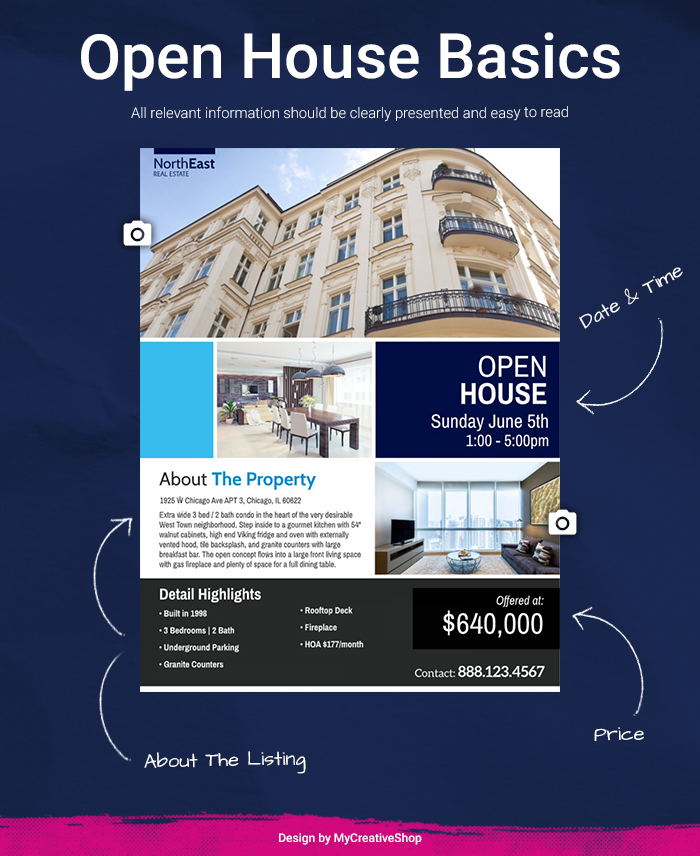 Open House Basics[/caption] All relevant information should be clearly presented and easy to read. At the very least, list the property address (without abbreviations like Rd, St, or N), the open house date and time, your logo and contact information, and a few high-quality photos and/or highlights of the property. Remember to use large, high-contrast fonts so that readers don t have to squint to find out who you are or what you re selling.
Open House Basics[/caption] All relevant information should be clearly presented and easy to read. At the very least, list the property address (without abbreviations like Rd, St, or N), the open house date and time, your logo and contact information, and a few high-quality photos and/or highlights of the property. Remember to use large, high-contrast fonts so that readers don t have to squint to find out who you are or what you re selling. 6. Combine print and digital.
As we mentioned before, social media platforms, listing websites, and neighborhood interest groups have drastically changed how homes are listed, shown, found, and sold. But that doesn t mean that you should skip print altogether; it just means that you should be tying your print and digital marketing together. Here are a few examples of successful multichannel marketing:- Include your website, email address, and any social media profiles on all of your print materials.
- Use specific URLs or QR codes on all of your print materials so that you can track conversions.
- Announce new listings, open houses, and sold properties on social media as well as through direct mail marketing.
- Have attendees sign in via a real estate open house app that automatically enters them into your CRM or automated email marketing.
- Share photos of your open houses and other events on social media.
 PhotoMIX-Company / Pixabay[/caption] Whew! The six recommendations above may sound like a lot to take in...but once you ve mastered them, you ll have a solid foundation for all kinds of real estate marketing: postcards, flyers, social media, and more. So now that we ve got the generals out of the way, let s move into the specific print materials you need for a successful open house.
PhotoMIX-Company / Pixabay[/caption] Whew! The six recommendations above may sound like a lot to take in...but once you ve mastered them, you ll have a solid foundation for all kinds of real estate marketing: postcards, flyers, social media, and more. So now that we ve got the generals out of the way, let s move into the specific print materials you need for a successful open house. Before the Open House: Leveraging Print to Attract Guests
You know that much more goes into a successful open house than just announcing it and waiting for people to walk through the door. In the weeks and days leading up, make sure your open house is set up for success by effectively using print marketing to spread the word. Try out these four methods below!1. Open house flyers
[caption id="" align="alignnone" width="800"] Open House Flyer Template via MyCreativeShop[/caption] Flyers can be distributed hyper-locally within the neighborhood, on public bulletin boards throughout the community, or in your real estate agency s window. If you have the budget, you can also run a version of your open house flyer in the local paper.
Open House Flyer Template via MyCreativeShop[/caption] Flyers can be distributed hyper-locally within the neighborhood, on public bulletin boards throughout the community, or in your real estate agency s window. If you have the budget, you can also run a version of your open house flyer in the local paper. Extra tip: Generate a little more buzz by offering exclusive events and advertising them via flyer! For instance, you could host a special neighbors-only open house, offer a free seminar for first-time home buyers, or bundle several open houses in the same neighborhood into an exciting mega-event.
2. Open house postcards
[caption id="" align="alignnone" width="800"]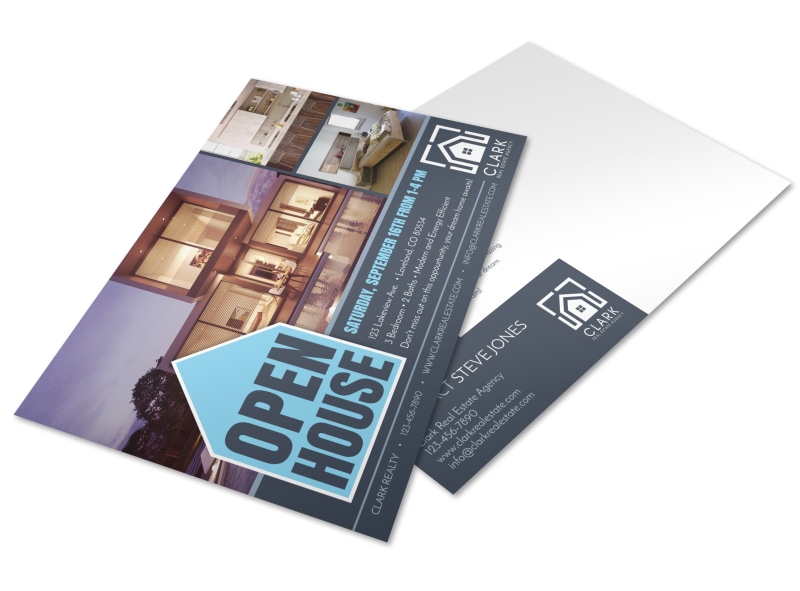 Open House Postcard Template via MyCreativeShop[/caption] Sending out direct mail postcards is a cost-effective way to target potential home buyers in your local community, especially if you use an automated service such as USPS Every Door Direct Mail (EDDM) . On your postcards, be sure to include all relevant information, including the property address, open house date and time, your contact information, and any special events (e.g. raffles, giveaways, or charitable donations) that will take place.
Open House Postcard Template via MyCreativeShop[/caption] Sending out direct mail postcards is a cost-effective way to target potential home buyers in your local community, especially if you use an automated service such as USPS Every Door Direct Mail (EDDM) . On your postcards, be sure to include all relevant information, including the property address, open house date and time, your contact information, and any special events (e.g. raffles, giveaways, or charitable donations) that will take place. 3. Open house door hangers
[caption id="" align="alignnone" width="800"] Open House Door Hanger Template via MyCreativeShop[/caption] Door hangers are another effective tool for spreading awareness about an open house. Some people actually knock to share the news in person, but others find this method a little too intrusive. If you aren t sure, ask your clients which would be most appropriate for their neighborhood.
Open House Door Hanger Template via MyCreativeShop[/caption] Door hangers are another effective tool for spreading awareness about an open house. Some people actually knock to share the news in person, but others find this method a little too intrusive. If you aren t sure, ask your clients which would be most appropriate for their neighborhood. 4. Open house yard signs
[caption id="" align="alignnone" width="800"] Open House Yard Sign Template via MyCreativeShop[/caption] If you think yard signs are dead, think again! According to the National Association of Realtors (NAR) Home Buyer and Seller Generational Trends Report 2017, 49% of home buyers use yard signs as an informational source. Along with the standard for sale yard signs, try adding:
Open House Yard Sign Template via MyCreativeShop[/caption] If you think yard signs are dead, think again! According to the National Association of Realtors (NAR) Home Buyer and Seller Generational Trends Report 2017, 49% of home buyers use yard signs as an informational source. Along with the standard for sale yard signs, try adding: - A prominent open house sign
- Large vertical flag signs
- Directional yard signs within a five-block radius
- Balloons, ribbons, flowers, or other eye-catching decorations
During the Open House: Greeting and Informing Attendees
Once you ve actually brought guests to your open house, the work of selling the home has really just begun. Fortunately, informative, well-designed print materials can make that job much easier! With the right open house print materials, you ll not only keep visitors occupied and interested while you re running to and fro with hosting duties; you ll also give them something to take home as a reminder of the open house. [caption id="attachment_3702" align="alignnone" width="700"] HobokenHome7 / Pixabay[/caption] For a smooth and well-organized open house, include these four different print materials:
HobokenHome7 / Pixabay[/caption] For a smooth and well-organized open house, include these four different print materials: 1. Welcome resources
Ideally, you d be able to greet each visitor as soon as they walk through the door but you know how busy open houses can get! Make sure guests feel welcome by setting out the right resources by the front door:- Welcome signs or posters
- A professionally designed, branded sign-in sheet
- Your business cards and/or meet the team flyers
- Sell sheets and property flyers (...more on that next!)
2. Property fact sheets
Property fact sheets go by a dozen different names: listing flyers, sell sheets, face sheets, hot sheets But they all boil down to providing a brief summary of the property for sale. [caption id="attachment_3704" align="alignnone" width="700"]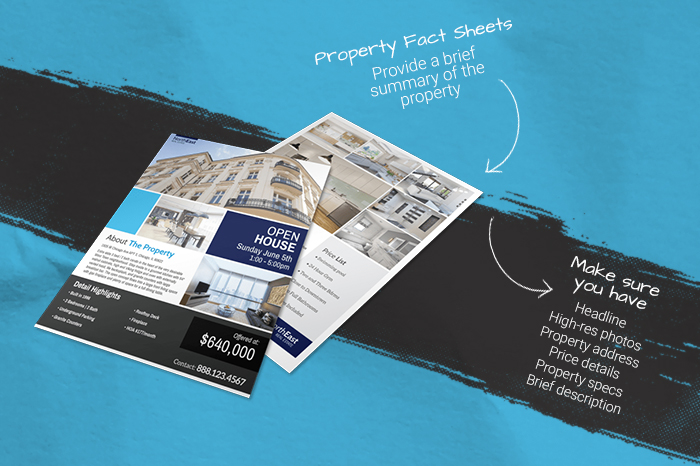 Property Fact Sheets[/caption] Property fact sheets typically fit on a single 8.5x11" page and include:
Property Fact Sheets[/caption] Property fact sheets typically fit on a single 8.5x11" page and include: - An attention-grabbing headline
- High-resolution photos of the property
- The property s address
- Some reference to price (either the listing price, a range, or a note to contact you for pricing details)
- A bulleted list of essential information: square footage, beds, baths, etc.
- Brief descriptions of the home s most attractive features
3. Other handouts
Every property should have a basic sell sheet, but you can make yourself stand out as a real estate agent by providing even more information. After all, most families care about more than just the house; they want to know whether they could see themselves at home in this space. From single-sheet pages to full-size real estate brochures, you can create tons of information-packed handouts on topics such as: [caption id="" align="alignnone" width="800"] Open House Tri-Fold Brochure Template via MyCreativeShop[/caption]
Open House Tri-Fold Brochure Template via MyCreativeShop[/caption] - HOA fees and administration
- Average local utilities rates
- Property tax costs
- Available providers for internet, landline, and cell service
- Key home sales/ownership terms (especially helpful for first time buyers)
- Neighborhood information: education quality, walkability, crime rates, annual festivals or celebrations
- Local amenities: closest 24-hour pharmacy, best grocery stores, public dog parks, jogging trails, playgrounds, dry cleaning services
 Real Estate Pocket Folder Template via MyCreativeShop[/caption]
Real Estate Pocket Folder Template via MyCreativeShop[/caption] 4. Feedback forms
The best time to get feedback on your open house is as your guests leave. With a professionally branded feedback form at the door, you can leave a final good impression with viewers while also getting their honest opinion on the property. Include a call to action for them to contact you to discuss their feedback privately or to move forward with an offer.After the Open House: Maintaining the Relationship
Once you ve established rapport with guests at your open house, you can then use print materials to stay top-of-mind and maintain that relationship far into the future. Through direct mailing, you can even continue to target local homeowners who didn t attend your open house. [caption id="attachment_3706" align="alignnone" width="700"] geralt / Pixabay[/caption] Postcards and flyers are especially great for:
geralt / Pixabay[/caption] Postcards and flyers are especially great for: - Thanking attendees for coming
- Announcing a reduced listing price
- Showing off a just sold listing
- Sharing the latest neighborhood housing marketing prices and developments
- Inviting recipients to another open house
- Offering referral specials
Just Sold! Taking Print Beyond the Open House
Just like the house you re showing off, you only have one chance to make a good impression on the potential home buyers and sellers of your community. So set yourself apart from other local real estate agents with informative, well-branded, and professionally printed materials! Whether you re door-hanging to advertise a new listing or greeting guests at your jam-packed open house, you ll establish yourself as the go-to community professional. Need some help creating your open house flyers, property fact sheets, or other real estate marketing materials? MyCreativeShop has you covered! Try out our easy-to-use online editor and start building your real estate brand with customized design.